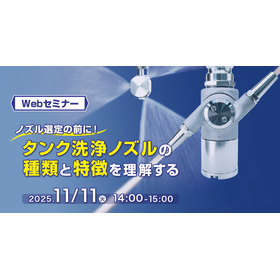ブロア用二流体ノズル 「ブロアミストノズル」
廃棄物処理場などでの粉塵対策に最適!ブロアエアーで省エネ効果
エアー源にブロアを使用し、微細なミストを噴霧します。コンプレッサー式からブロア式への転換で省エネ化の促進が可能。電気代使用料を大幅削減します。 液の供給方法は、エアー流により液を吸い上げる「サイフォン式」と、液を圧送する「加圧式」の2タイプがあります。 廃棄物処理場などでの粉塵対策やミスト冷房に最適です。 詳しくは、カタログをダウンロード、もしくはお問い合わせください。 スプレーノズルのグローバルブランドであるスプレーイングシステムスは、 9万アイテム以上の実績をもとに様々な用途にあったノズルを提供しています。 ※スプレーイングのノズルについてはPDFダウンロードまたはお問い合わせください。
基本情報
【サイフォン式ブロアミスト】 <特長> ○ブロアの風速により、タンクなどから液を吸い上げ、微細なミストをラウンド状に噴霧します。 ○複数のノズルを数mずつ離れた位置に設置し、1台のブロワから分岐させたエアーで全部のノズルを噴霧する場合でも、各ノズルは同じ噴霧性能を発揮し 、微調整の必要はありません。 <ノズルからの距離とスプレー幅> ○2 m→0.7 m ○3 m→0.9 m 【加圧式ブロアミスト】 <特長> ○ブロアの風力と微圧の液圧により、スプレーが遠くまで到達。 フラット状噴霧で広い範囲をカバーします。 ○大口径オリフィスで目詰まりしにくく、周辺環境の影響を受けにくい設計です。 <ノズルからの距離とスプレー幅> ○1 m→0.6 m ○3 m→1.5 m ○5 m→1.6 m 詳しくは、カタログをダウンロード、もしくはお問い合わせください。
価格情報
- 詳細はお問合せ下さい。
納期
用途/実績例
【用途】 ○一般工場・清掃工場・廃棄物処理工場などでの粉塵防止 ○消臭剤・除菌剤の散布 ○冷却 ○加湿・湿潤 ○ミスト冷房 ○精密洗浄 ○その他
カタログ(8)
カタログをまとめてダウンロードおすすめ製品
取り扱い会社
スプレーノズルのグローバルブランドであるスプレーイングシステムスは、9万アイテム以上の実績をもとに様々な用途にあったノズルを提供しています。 ■スプレーノズルをはじめ加湿器、洗浄機、塗布装置から防塵、冷却、潤滑などスプレー技術に関することはお気軽にご相談ください。 ■全国5ヵ所に「テクニカル テストルーム」を常設。ノズルを実際に手に取り、さまざまな条件でスプレートライすることによって真にお客様の目的に合ったスプレーノズルをお選びいただけます。 ■標準品は2万種類以上。全産業の用途に最適のノズルを取り揃えております。 ■特殊仕様の製作、システムの設計施工につきましても1個1台から承ります。 ■ISO9001、ISO14001認証取得(八日市場工場) ■用途例:ジェット洗浄、高圧洗浄、散布、散水、加湿、塗布、エッチング、現像、水膜薄膜、静電気防止、調湿、粉塵防止、鎮塵、剥離、排水処理、消泡、消臭、接着剤、離型、スケール落とし、表面処理、防錆、耳切り、切断、成形、栽培、塗装前処理、エアーブロー、オイリング、反応、造粒、防火、冷却 スプレーイングのノズルについてはこちらからお問い合わせください。













































